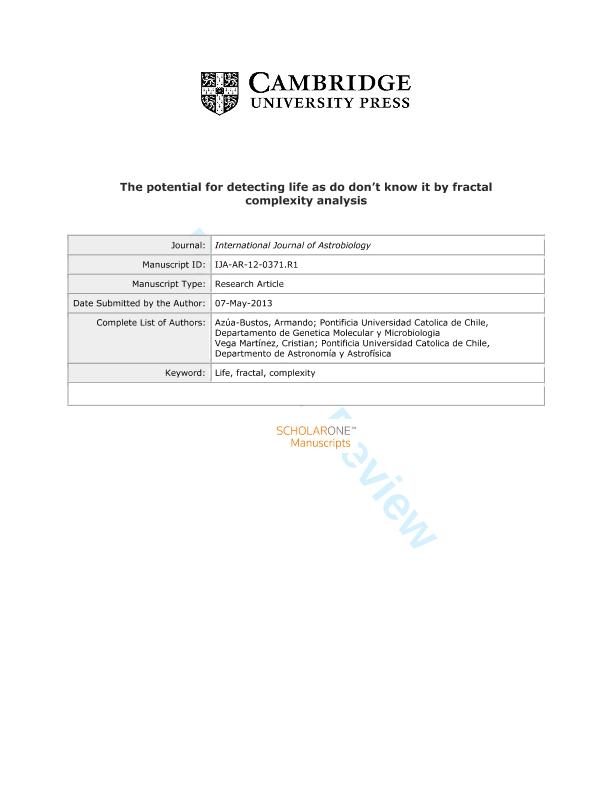Mostrar el registro sencillo del ítem
dc.contributor.author
Azúa Bustos, Armando
dc.contributor.author
Vega Martínez, Cristian Antonio

dc.date.available
2017-10-09T18:26:17Z
dc.date.issued
2013-10
dc.identifier.citation
Azúa Bustos, Armando; Vega Martínez, Cristian Antonio; The potential for detecting "life as we don't know it" by fractal complexity analysis; Cambridge University Press; International Journal Of Astrobiology; 12; 4; 10-2013; 314-320
dc.identifier.issn
1473-5504
dc.identifier.uri
http://hdl.handle.net/11336/26238
dc.description.abstract
Finding life in the Universe entirely different to the one evolved on Earth is probable. This is a significant constraint for life-detecting instruments that were sent and may be sent elsewhere in the solar system, as how could we detect life as ‘we don't know it’? How could we detect something when we have no prior knowledge of its composition or how it looks like? Here we argue that disregarding the type of lifeform that could be envisioned, all must share in common the attribute of being entities that decrease their internal entropy at the expense of free energy obtained from its surroundings. As entropy quantifies the degree of disorder in a system, any envisioned lifeform must have a higher degree of order than its supporting environment. Here, we show that by using fractal mathematics analysis alone, one can readily quantify the degree of entropy difference (and thus, their structural complexity) of living processes (lichen growths and plant growing patterns in this case) as distinct entities separate from its similar abiotic surroundings. This approach may allow possible detection of unknown forms of life based on nothing more than entropy differentials of complementary datasets. Future explorations in the solar system, like Mars or Titan, may incorporate this concept in their mission planning in order to detect potential endemic lifeforms.
dc.format
application/pdf
dc.language.iso
eng
dc.publisher
Cambridge University Press

dc.rights
info:eu-repo/semantics/openAccess
dc.rights.uri
https://creativecommons.org/licenses/by-nc-sa/2.5/ar/
dc.subject
Complexity
dc.subject
Fractal
dc.subject
Life
dc.subject.classification
Otras Ciencias Físicas

dc.subject.classification
Ciencias Físicas

dc.subject.classification
CIENCIAS NATURALES Y EXACTAS

dc.title
The potential for detecting "life as we don't know it" by fractal complexity analysis
dc.type
info:eu-repo/semantics/article
dc.type
info:ar-repo/semantics/artículo
dc.type
info:eu-repo/semantics/publishedVersion
dc.date.updated
2017-09-14T13:56:34Z
dc.journal.volume
12
dc.journal.number
4
dc.journal.pagination
314-320
dc.journal.pais
Reino Unido

dc.journal.ciudad
Cambridge
dc.description.fil
Fil: Azúa Bustos, Armando. Pontificia Universidad Católica de Chile; Chile
dc.description.fil
Fil: Vega Martínez, Cristian Antonio. Consejo Nacional de Investigaciones Científicas y Técnicas. Centro Científico Tecnológico Conicet - La Plata. Instituto de Astrofísica La Plata. Universidad Nacional de La Plata. Facultad de Ciencias Astronómicas y Geofísicas. Instituto de Astrofísica la Plata; Argentina
dc.journal.title
International Journal Of Astrobiology

dc.relation.alternativeid
info:eu-repo/semantics/altIdentifier/url/https://www.cambridge.org/core/journals/international-journal-of-astrobiology/article/potential-for-detecting-life-as-we-dont-know-it-by-fractal-complexity-analysis/81169D2F63946BCA4BB0DE6548597663
dc.relation.alternativeid
info:eu-repo/semantics/altIdentifier/url/http://adsabs.harvard.edu/abs/2013IJAsB..12..314A
dc.relation.alternativeid
info:eu-repo/semantics/altIdentifier/doi/https://doi.org/10.1017/S1473550413000177
Archivos asociados
